16.05
→
22.06.22
COUPLE
(Adam Cruces & Louisa Gagliardi)
Fool's
Gold
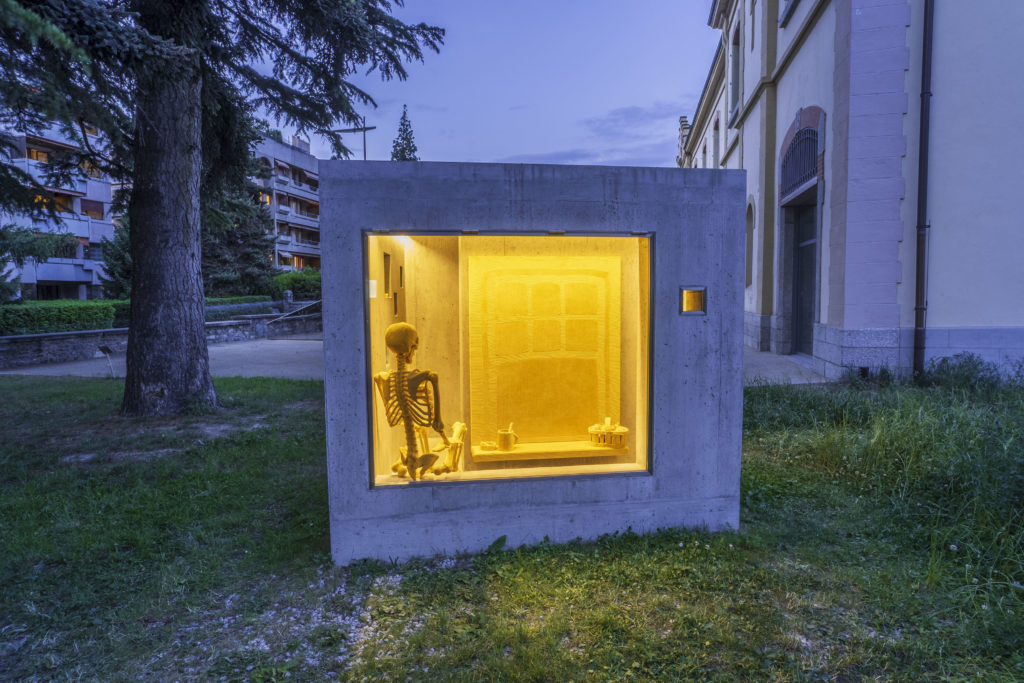
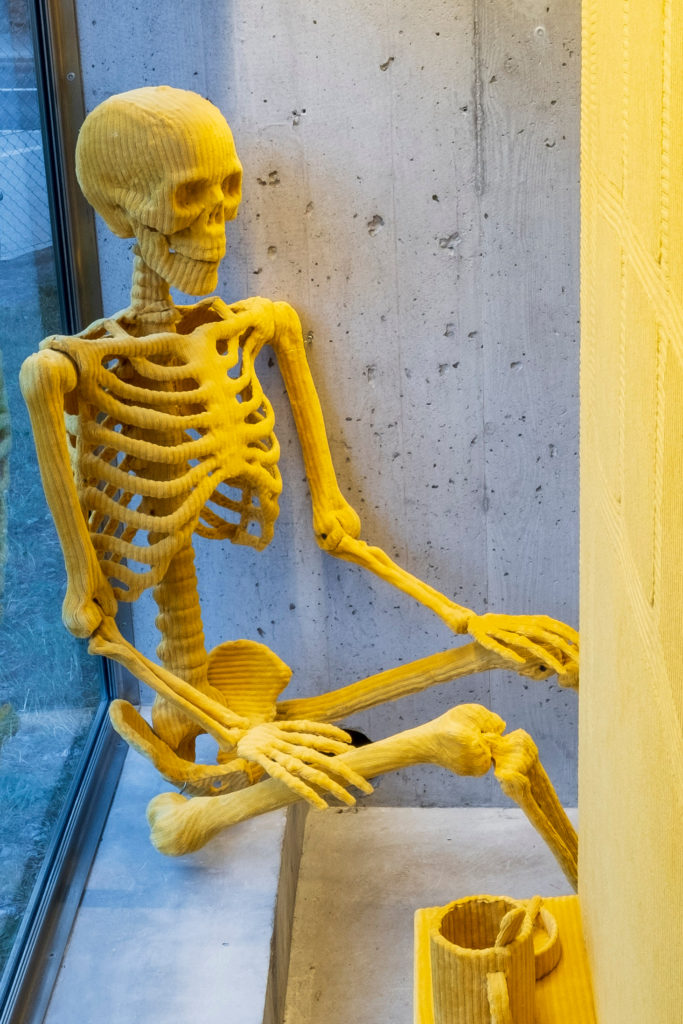
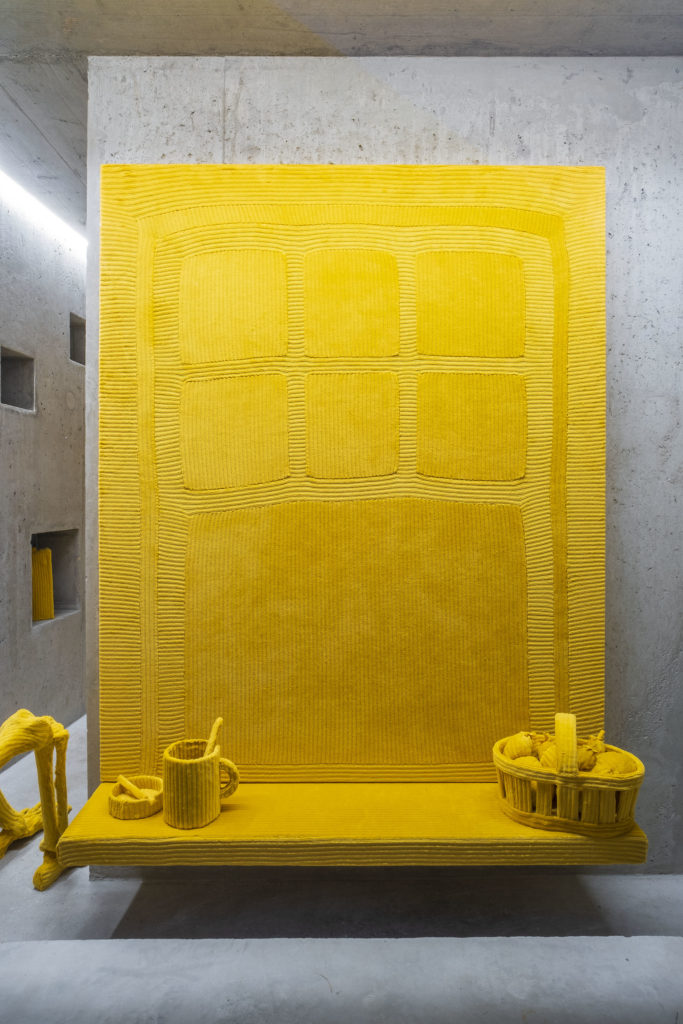
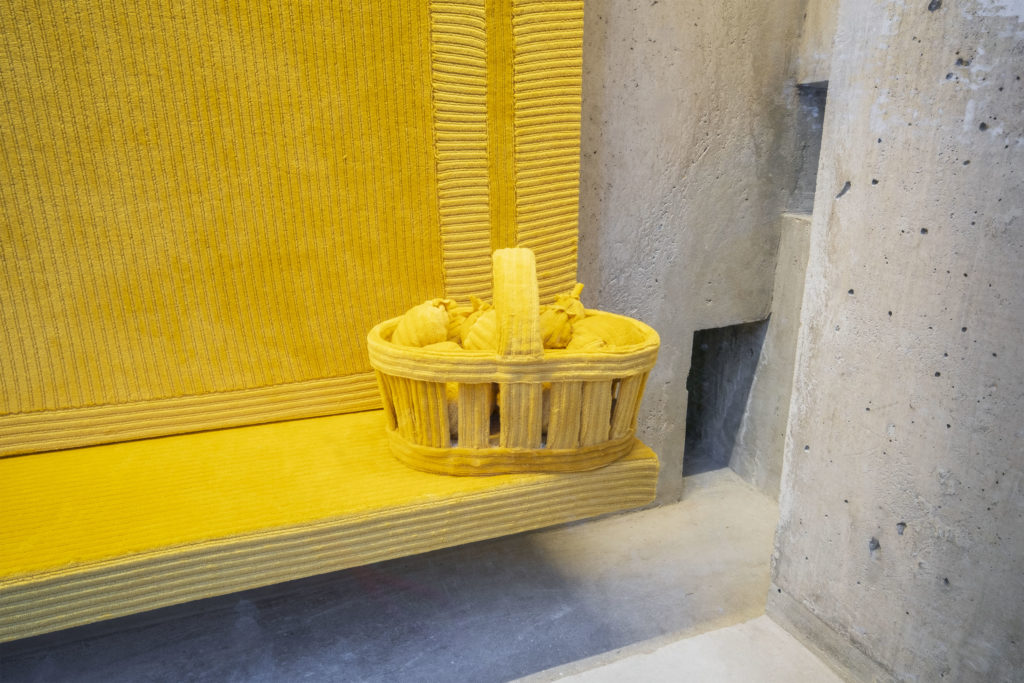
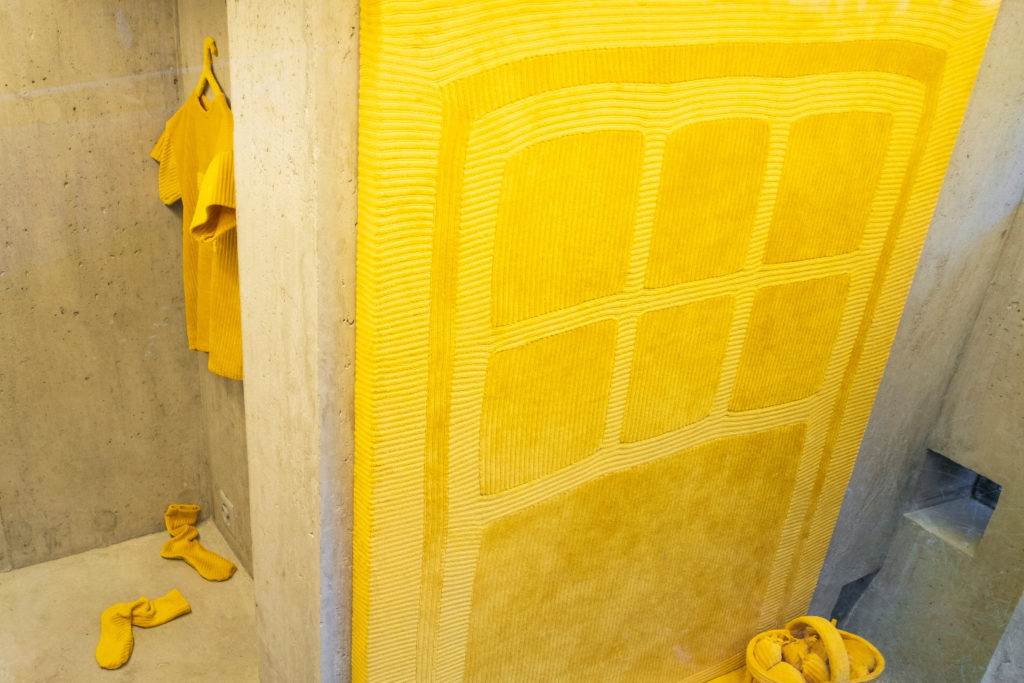

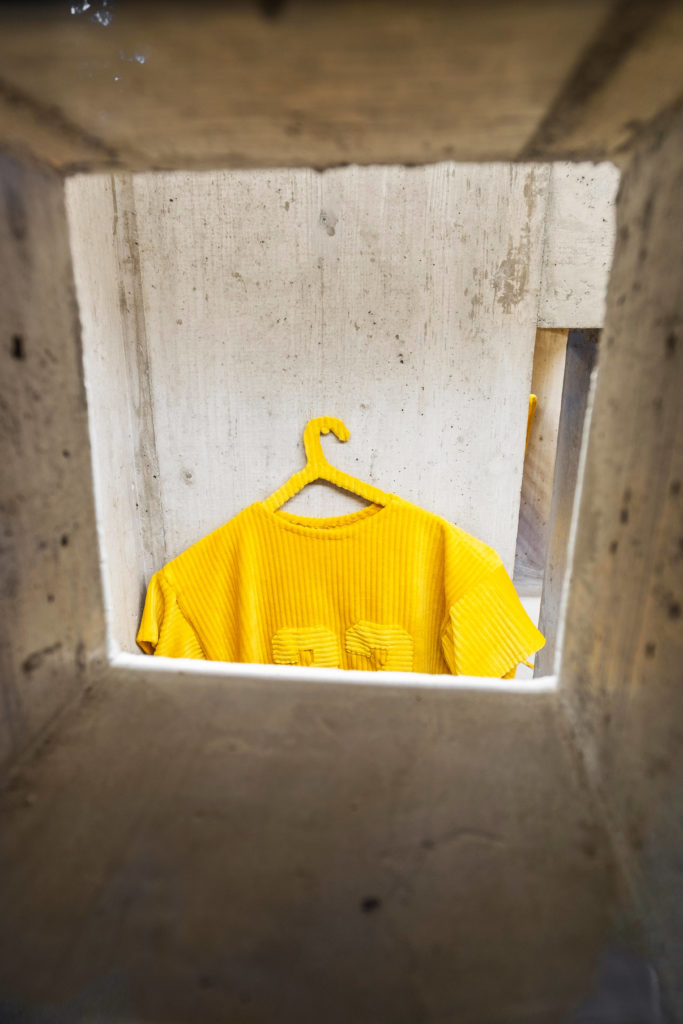
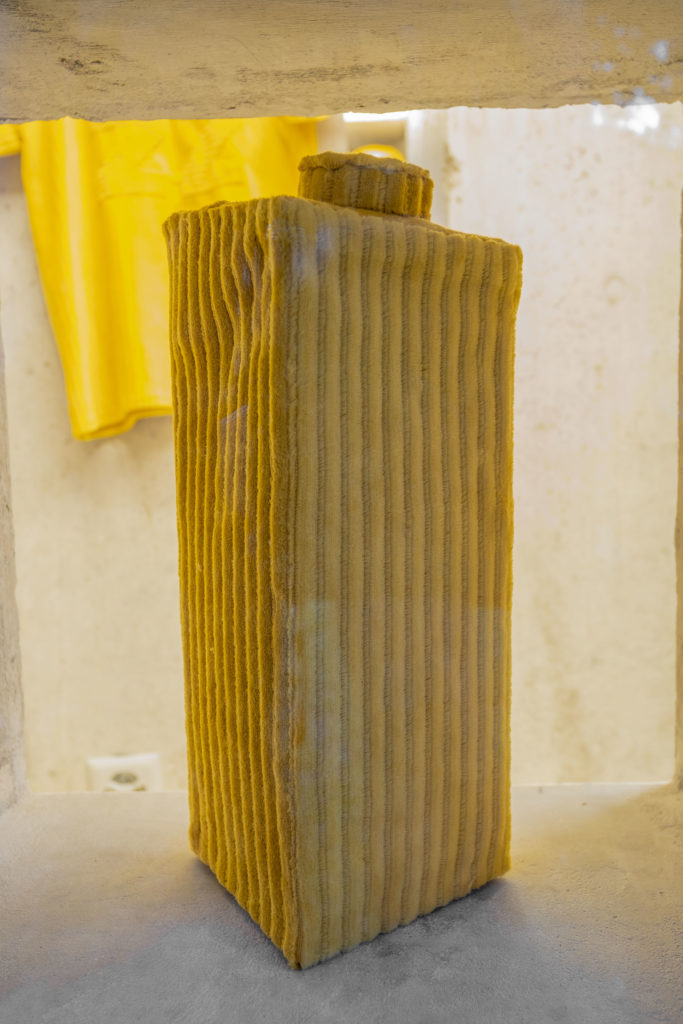
Eine Welt aus Cord
Katzengold und Ockergelb
Der von COUPLE (Adam Cruces & Louisa Gagliardi) gewählte Titel Fool’s Gold löste bei mir lebhafte Erinnerungen an glückliche Kindheitsstunden in der Mineraliengrube Lengenbach im Binntal aus. In dieser Grube war ich umgeben von eben diesem Fool’s Gold, zu deutsch Katzengold und wähnte mich dank den massenhaften Vorkommen des Gesteins Pyrit in einem Traum aus Gold. Eine frühe Erfahrung der Verführungskraft von Imagination und Täuschung und der Immersion in eine andere Realität.
Hier, in der Ausstellung von COUPLE in Lemme, bezieht sich Fool’s Gold auf die ockergelbe Farbe des Cords, aus dem alle Exponate gefertigt sind: zwei Skelette, verschiedene Alltagsobjekte, ein Kissen und zwei Wandarbeiten. Während Katzengold – Pyrit – als Pigment einen grauen Farbton aufweist, der im Sonnenlicht an Gold erinnert und ein unbeständiges Mineral ist (es zersetzt sich in sauerstoffreicher und feuchter Atmosphäre), sind Ockerpigmente langlebig und flexibel einsetzbar. Ocker wurde schon vor über 70’000 Jahren als Kosmetik, für rituelle Zwecke und in der Kunst eingesetzt. Auf den Böden einiger Höhlen wurden erstaunlich dicke Schichten des Pigments nachgewiesen, weil Menschen damit nicht nur Wände, sondern auch ihre Körper bemalt haben dürften. Auch Pyrit konnte in Grotten nachgewiesen werden, da das Mineral als Feuerstein Verwendung fand. Die Materialien Ocker und Pyrit könnten sich also in steinzeitlichen Höhlen begegnet sein; in der Installation Fool’s Gold treffen sie durch die allesumfassende Farbe Ockergelb und den Titel aufeinander. Sie sind aus drei Gründen fruchtbar für die Analyse des Werks. Erstens kommen beide Materialien auf dem ganzen Planeten häufig vor und werden schon seit Urzeiten von den Menschen genutzt, was auf die Universalität und Zeitlosigkeit der Installation verweist. Ihre Eigenschaften als Pigmente sind zweitens gegensätzlich – Ocker ist beständig, Pyrit nicht, was auf die spannungsvollen Beziehungen zwischen verschiedenen parallelen Zeiten in Fool’s Gold hindeutet: Die Skelette versetzen uns in eine tiefe Vergangenheit, während die verschiedenen Alltagsobjekte dieses häuslich eingerichteten Paars einen Bezug zur heutigen Lebenswelt schaffen und die Nummer 22 des Shirts gar auf das aktuelle Jahr anspielt. Es entsteht der Eindruck, dass Lemme eine Zeitkapsel ist. Nur ist unklar, wann diese aufgenommen wurde: 2022, in den 1980er-Jahren, Ende des 19. Jahrhunderts oder vor 70’000 Jahren? Drittens stehen beide Materialien für Räume der Imagination und der Illusion, mit denen wir es auch in dieser Ausstellung zu tun haben.
Skelette, Alltagsobjekte, Bilder
Wenn man sich Lemme nähert, drängt sich zuallererst auf, dass die ausgestellten Skelette, Alltagsobjekte und Wandarbeiten alle mit derselben ockergelben Stofflichkeit übertüncht sind. Dadurch stellt sich der Eindruck ein, dass sie alle derselben alternativen Realität entspringen. Die weiche Qualität des Cords und seine Rippen sind wie dafür gemacht, den Skeletten eine Lebendigkeit zu geben. Beim Kissen und bei den zwei Wandarbeiten werden die Eigenheiten des Cords dafür genutzt, Bilder zu generieren. Diese Bilder werden von einem kulturellen Archiv gespiesen und verquicken kunsthistorische Bezüge mit universellen Symbolen und popkulturellen Motiven.
Die Malerei ist sowohl in den individuellen künstlerischen Praktiken Gagliardis und Cruces’ als auch in der Kollaboration COUPLE zentral. Deshalb wundert es nicht, dass sich in Fool’s Gold verschiedene Referenzen auf die Kunstgeschichte der Malerei finden. Die Installation als Ganzes kann als Stillleben gelesen werden: Die Schädel der Skelette, der Apfel im Kippbild, der Früchtekorb und die verschiedenen Frühstücksgegenstände (eine Tasse, eine Milchpackung, ein Butterbrot mit Messer, wenn man denn will auch der Aschenbecher mit Zigarette) gehören zu den vielfach verwendeten Motiven dieses Genres.
Während die Rippen des Cords «gekippt» werden, um Bilder herzustellen, kippt die Wahrnehmung des Kissenbildes zwischen einem Apfel und zwei Gesichtern – den Profilen Gagliardis und Cruces’ – hin und her. Derartige Kippfiguren waren Ende des 19. Jahrhunderts sehr populär. Die Kippfigur auf dem Kissen ist denn auch eine Variation eines bekannten Bilds aus dieser Zeit, das bis heute zum Standardrepertoire gehört, um Wahrnehmungsphänomene zu illustrieren. COUPLE haben die Rubinsche Vase durch einen Apfel ersetzt. Der Apfel ist ein altes Symbol für Fruchtbarkeit, Sexualität und Versuchung und spielt als Frucht des Lebens, die zum Sündenfall und zur Vertreibung Adams und Evas aus dem Paradies führt, auch eine Rolle in der westlichen Kunstgeschichte. Die Kippfigur auf dem Kissen kann also nicht nur als Variation eines bekannten Bildtypus, sondern auch als zeitgenössische Interpretation des Adam und Eva-Komplexes gelesen werden. Denn dieser Apple erinnert an den Technologieriesen mit selbigem Namen. Die zwei Umrisse treten des Weiteren unweigerlich in einen Dialog mit den Skeletten. In welcher Art und Weise sind sie miteinander verbunden? Sind die Umrisse die Skelette?
Eine der Wandarbeiten nimmt mit dem Fenstermotiv ein seit der Renaissance beliebtes Thema der Malerei auf. Traditionellerweise öffnet das Fenster in einem imaginären Bildraum ein Abbild der Welt. Seit der Moderne wurde dieses Thema selbstverständlich zahllose Male variiert und hinterfragt. COUPLE nutzen nun die besonderen Blickbeziehungen, welche Lemme generiert, um einen doppelten Fensterblick herzustellen, der jedoch ins Leere läuft: Wir, die Besucher:innen, blicken durch ein Fenster auf das Skelett, welches wiederum durch ein Fenster schaut. Doch was die Figur sieht, können wir nicht erkennen – denn wir gehören nicht derselben Welt aus Cord an. Vielleicht liefert das Filmplakat von Stanley Kubricks Horrorfilm The Shining (1980), welches auf der zweiten Wandarbeit zu sehen ist, einen Schlüssel? Der Film spielt im historischen Overlook-Hotel in den Bergen von Colorado, um das sich Jack Torrance (Jack Nicholson) in der Zwischensaison mit seiner Familie kümmert. Sein Sohn Danny hat the shining: die Gabe, Übersinnliches wahrzunehmen, was in diesem Fall vor allem Grusliges meint. Den Bezug zu diesem Film sieht COUPLE in der klaustrophobischen Enge des Raums und den umgebenden Bergen. Das Overlook-Hotel ist ein Ort, der gleichzeitig Horror (für die Hausmeister:innen in der Wintersaison) und das Paradiesische (für die Sommergäste) versinnbildlicht. Vorlage für den Film war ein Hotel, das um 1900 als Sanatorium in Colorado gebaut wurde, als ehemalige Höhenklinik aber genauso gut im Wallis stehen könnte. So entsteht eine imaginäre Verbindungslinie zwischen dem Skelett-Paar in Lemme und den verschiedenen temporären Bewohner:innen des Hotels in Colorado. Ob die Skelette den Ausblick in eine paradiesische Landschaft geniessen oder dem Horror in die Augen blicken, bleibt verborgen.
Josiane Imhasly
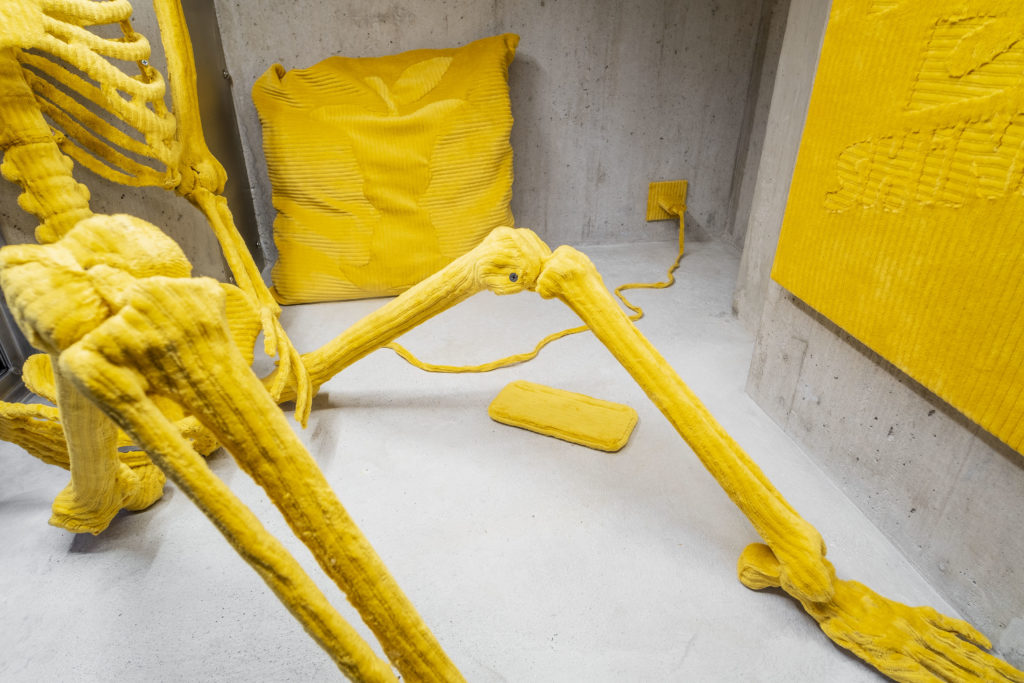
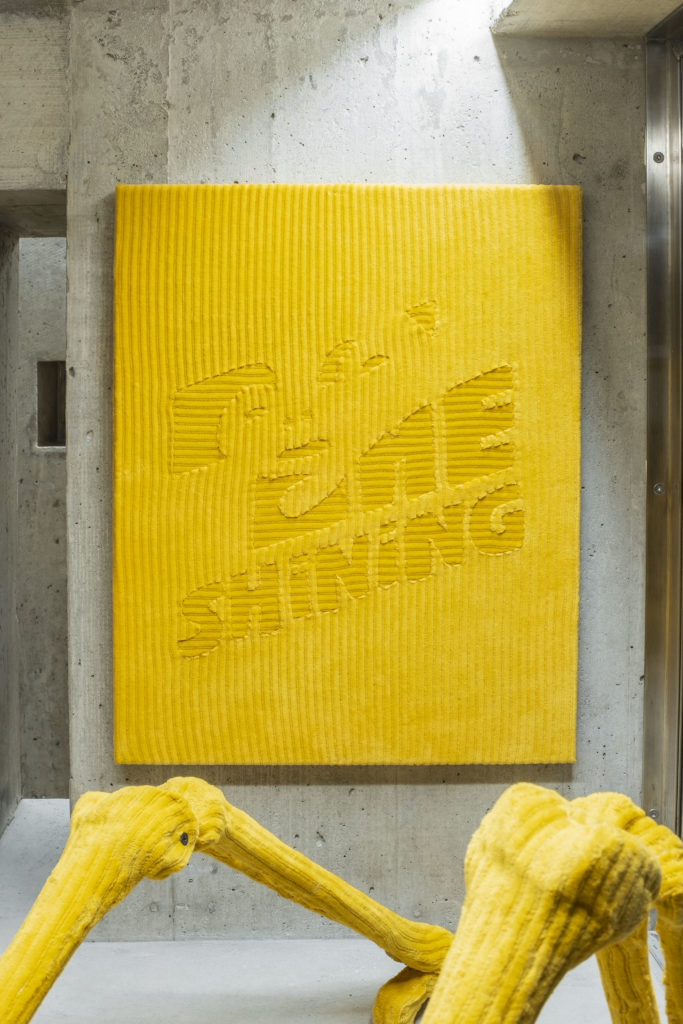
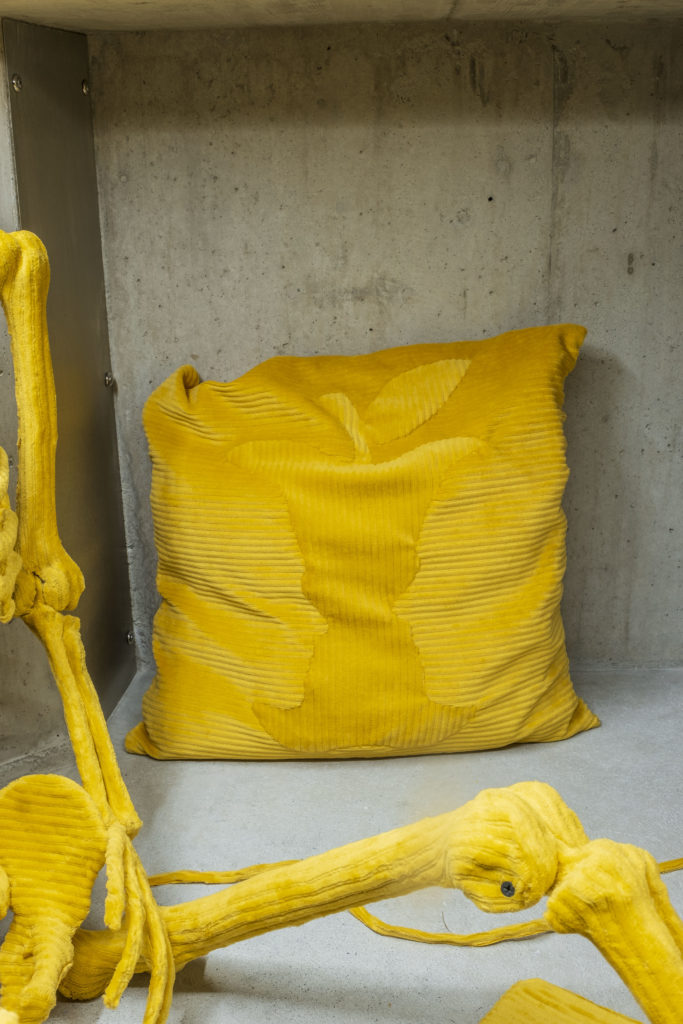

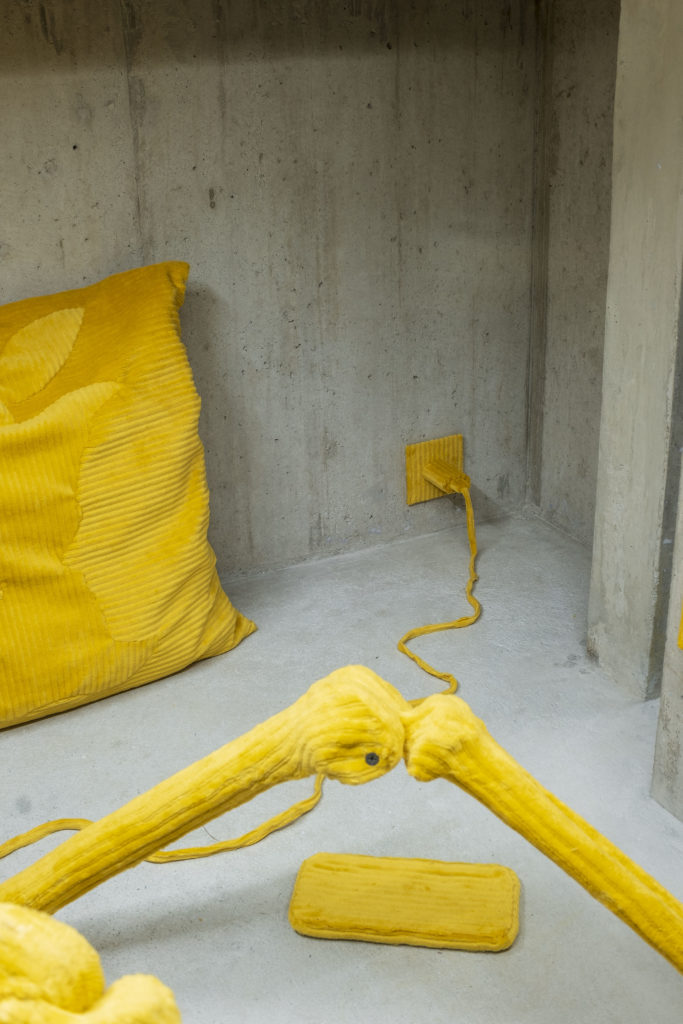
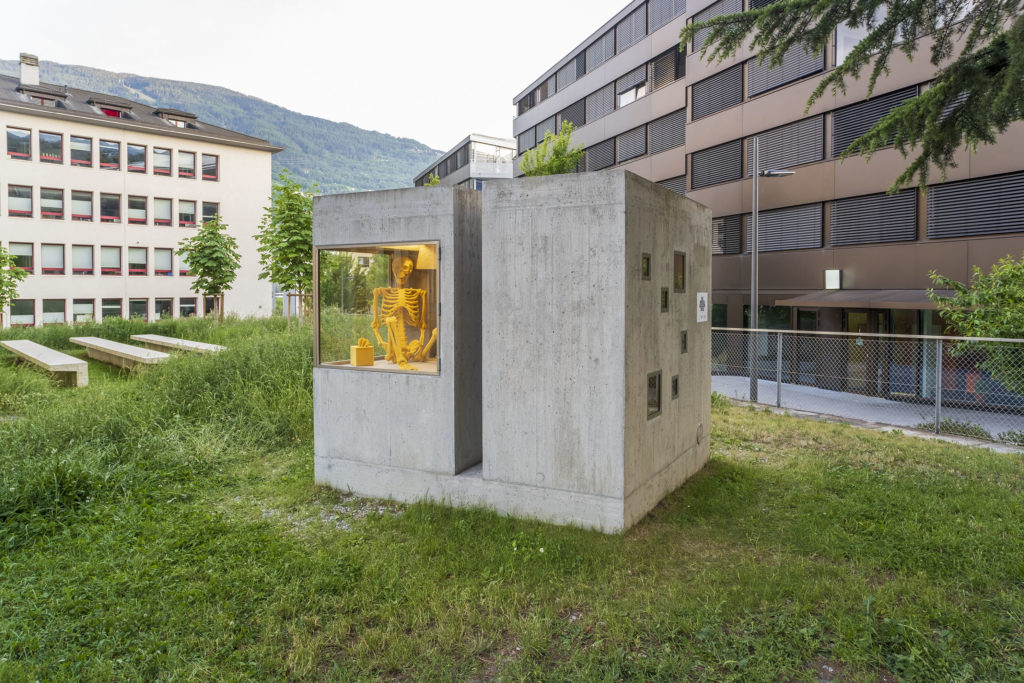
A World of Corduroy
Fool’s Gold and Ochre Yellow
The title Fool’s Gold that COUPLE (Adam Cruces & Louisa Gagliardi) chose for this exhibition sparked vivid memories of the blissful childhood hours I spent at the Lengenbach mineral mine in the Binn Valley. Surrounded by “fool’s gold” at the mine, I pictured myself in a golden dream world, thanks to the massive deposits of the mineral pyrite. It was an early experience of the seductive power of imagination and deception and of the immersion in an alternative reality.
In COUPLE’s exhibition at Lemme, Fool’s Gold refers to the ochre-yellow colour of the corduroy that covers everything on display: two skeletons, various everyday objects, a pillow, and two wall pieces. As a pigment, fool’s gold – pyrite – has a greyish hue resembling gold in the sunlight and is an unstable mineral (it decomposes in an oxygen-rich and humid atmosphere). Meanwhile, ochre pigments are long-lasting and can be used in a variety of ways. Ochre featured in cosmetics, rituals, and art over 70,000 years ago. Surprisingly thick layers of the pigment have been found on cave floors; people may have used it to paint not only the walls but also their bodies. Pyrite has also been found in caves, where the mineral was used to spark fires. The materials ochre and pyrite could thus have come together during the Stone Age. In the installation Fool’s Gold, they meet through the all-encompassing colour of ochre yellow and the title. Knowing their characteristics is helpful for the analysis of the artwork for three reasons. First, both materials are found all over the planet and have been used by humans since prehistoric times, which points to the universality and timelessness of the installation. Second, as pigments, their properties are antithetical: ochre is durable, but pyrite is not. This aspect suggests the tension between the different parallel times conveyed in Fool’s Gold. The skeletons transport us deep into the past, while the everyday objects surrounding this domestically furnished couple create a connection to today’s world – the number 22 on the shirt even alludes to the current year. The impression this makes is of Lemme as a time capsule. Only the year it represents is unclear: 2022, the 1980s, the late-19th century, or 70,000 years ago? Third, both materials stand for the imagination and illusion, themes that this exhibition also addresses.
Skeletons, everyday objects, pictures
When approaching Lemme, the first thing that catches the eye is that everything on display – the skeletons, everyday objects, and wall pieces – is covered in the same ochre-yellow fabric. This gives the impression that they all spring from the same alternative reality. The soft quality of the corduroy and its ribbed contours are perfect for lending the skeletons a sense of vitality. In the case of the pillow and the two wall pieces, the characteristics of the corduroy are used to generate images. These images are informed by a cultural archive, combining references from art history with universal symbols and pop culture motifs.
Painting is central to the individual artistic practices of both Gagliardi and Cruces and their COUPLE collaboration. So it is not surprising that various allusions to the history of painting can be found in Fool’s Gold. As a whole, the installation can be read as a still life: the skulls of the skeletons, the hidden apple in the reversible figure, the fruit basket, and the sundry breakfast objects (cup, milk carton, piece of toast with knife, even the ashtray with cigarette) are among the frequently used motifs of this genre.
While the corduroy ribs are shifted in direction to produce different images, our perception of the pillow image switches back and forth between an apple and two faces – the profiles of Gagliardi and Cruces. Such ambiguous images were popular at the end of the 19th century. The figure on the pillow is a variation on a well-known motif from that time, which to this day belongs to the standard repertoire used to illustrate perceptual phenomena. COUPLE have replaced Edgar Rubin’s vase with an apple. The apple is an ancient symbol of fertility, sexuality, and temptation, and plays a role in Western art history as the fruit of knowledge, which leads to the Fall and the expulsion of Adam and Eve from Paradise. The pillow image is not only a variation on a familiar type of picture but also a contemporary interpretation of the Adam and Eve complex, the apple also being a nod to the technology giant of the same name. Furthermore, the two profiles inevitably enter into a dialogue with the skeletons – How are they connected? Are they the same as the skeletons?
One of the wall pieces takes up the window motif, which has been popular in painting since the Renaissance. Traditionally, the window opens up an image of the world through an imaginary pictorial space. Since modern times, of course, this theme has been varied and questioned countless times. COUPLE now makes use of the unique visual relationships that Lemme generates to offer a double window view. However, this view is ultimately thwarted: as visitors, we look through a window at the skeleton, which, in turn, looks through a window. But we are unable to recognize what the figure sees – we do not belong to the same corduroy world. Perhaps the movie poster for Stanley Kubrick’s horror film The Shining (1980), which features in the second wall piece, provides a key? The film is set in the Colorado mountains at the historic Overlook Hotel, which Jack Torrance (Jack Nicholson) takes care of with his family during the offseason. His son Danny has the “shining”: the gift of perceiving the supernatural, which in this case means mainly eerie occurrences. COUPLE sees the reference to this film in the claustrophobic confinement of the space and the surrounding mountains. As a setting, the Overlook Hotel simultaneously symbolizes horror (for the winter caretakers) and paradise (for the summer guests). It was inspired by a hotel built in the Rocky Mountains around 1900 that served as a resort and health retreat – as such, it could just as easily be in the Valais. This fact establishes an imaginary connection between the skeletal couple in Lemme and the temporary residents at the hotel in Colorado. Whether the skeletons enjoy the view of a paradisiacal landscape or look horror in the eye remains hidden.
Josiane Imhasly
The installation was realized with the support of SIGG LABS.